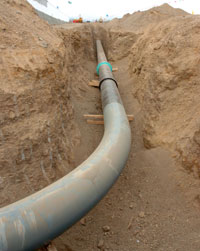
RUSSIAN GOVERNMENT SPELLING OUT BALTIC OIL TRANSPORT PLANS
Publication: Eurasia Daily Monitor Volume: 4 Issue: 77
By:

Addressing the “Pipeline Transport 2007” conference in Moscow on April 17, Transneft president Semyon Vainshtok and Deputy Industry and Energy Minister Andrei Dementiev declared that expansion of the Baltic Pipeline System (BPS) is currently the Russian government’s number-one priority for oil transportation (Interfax, RIA-Novosti, April 17).
BPS has quickly grown to a staggering capacity of 75 million tons annually as of 2006. Moscow’s intention to double that capacity poses clear threats to the maritime environment and navigation safety in the already congested Baltic Sea, particularly in its narrow passages and in the straits leading to the North Sea.
The existing system delivers oil from Russia’s interior through convergent pipelines to the port of Primorsk (and the smaller Ust-Luga nearby), at the Russian end of the Baltic Sea, for shipment to Western Europe by tankers. The expansion project envisages building a second phase, BPS-2, with a throughput capacity of another 75 million tons annually, and increasing Primorsk’s loading capacity by the same amount.
The Russian government plans to redirect into the BPS and to the Baltic Sea a large part of the oil flow from the Druzhba pipeline that runs from Russia via Belarus and Ukraine to European Union territory. Presumably, Moscow wants to reduce its reliance on overland export routes through third countries. Russia’s dispute with Belarus over oil export taxes and transit fees in January of this year precipitated Moscow’s policy decision to build BPS-2, so as to redirect much of the oil flow from the overland Druzhba route toward the maritime Baltic route.
When the Russian government first outlined those intentions (see EDM, February 6, March 7), it implied that it could reduce Druzhba to a mere trickle that would render that pipeline nonviable. That message was meant to pressure Belarus (and could also unnerve Ukraine) but was not entirely credible. It has now become clear that Russia will not give up on the Druzhba pipeline, but may slash the annual deliveries through that pipeline to less than half their present volume. Vainshtok made this clear at the Moscow conference, saying that the oil flow through Druzhba would be divided into two streams, one continuing westward and another heading northward to Primorsk.
BPS-2 would branch off from the Druzhba pipeline at the Unecha juncture on the Russian side of the Russia-Belarus border. Unecha handles a staggering 100 million tons of crude oil annually, including traditionally some 80 million tons headed via Ukraine to EU countries (tending slightly downward at 75 million in 2006) and another 20 million tons annually for processing at refineries in Belarus.
From that overall flow, Moscow plans to redirect up to 50 million tons into BPS-2. Skirting Belarus territory, the line would run through Russia’s Bryansk, Pskov, and Leningrad oblasts to Primorsk. According to Transneft’s management, the company could construct that pipeline in one and a half years, with a preliminary cost estimate of $2 billion to $2.5 billion (Kommersant, April 12). This would provide the bulk of the planned 75 million ton capacity increase for BPS and Primorsk.
Apparently, Russia counts on some volumes of oil from Kazakhstan to be routed to Primorsk through BPS. The Russian and Kazakh governments are currently discussing a project to increase the capacity of the Atyrau (Kazakhstan)-Samara (Russia) pipeline from 15 to 25 million tons of oil annually. Samara is a connecting point with the BPS-1. It seems likely that Moscow would use that additional volume of oil from Kazakhstan to fill Russia’s Baltic pipeline to Primorsk. That move also fits in with Russia’s goal to minimize Kazakhstan’s oil volumes available for westbound export through a trans-Caspian system (EDM, April 5; Institute for War and Peace Reporting Central Asia, April 9).
Primorsk’s export terminal loaded 18.5 million tons of oil in the first quarter of 2007 — a figure suggesting that it might actually load year-round more than its current design capacity of 75 million tons. The terminal is currently capable of accommodating medium-size tankers, but Transneft is involved in deepening the port to accommodate 160,000-ton capacity tankers, under an agreement with Russia’s leading shipping company, Sovkomflot.
Thus, the Russian government seems on track to expand Primorsk’s export capacity to 150 million tons of oil annually as planned. That target figure is triple the capacity of Novorossiysk (Russia’s largest maritime export terminal for oil until 2005) and is double the volume of Russian and Russian-loaded oil passing annually through the Bosporus at present.
Further adding to Baltic tanker traffic, Lukoil intends to ship some 12 million tons of crude oil and oil products annually, starting in 2008, from the port of Vysotsk. To that end, Lukoil chairman Vagit Alekperov and Russian Railroads president Vladimir Yakunin recently signed an agreement to increase the capacity of rail lines that connect Lukoil-owned refineries with Vysotsk (Leningrad oblast). The rail project is due for completion in December 2007. Lukoil is also adding two berths for oil tankers of 47,000-ton and 80,000-ton capacity at the company-owned Vysotsk export terminal (Interfax, April 2).
On top of these plans, Gazprom aims to build a liquefied-natural-gas and dedicated tanker port at Ust-Luga, also at the Russian end of the Baltic Sea. Gazprom is negotiating with Algeria’s state oil and gas company, Sonatrach, and the Calgary-based Petro-Canada to build those LNG installations for production and export.
Tanker traffic of this colossal magnitude out of Russia’s Baltic ports — alongside massive construction activities planned for the Northstream Gas Pipeline on the Baltic seabed, along the same route with its narrow passages — could adversely affect the entire Baltic basin. While the authorities and publics in Baltic Sea countries are increasingly preoccupied with the gas pipeline’s implications, Russia’s oil-transport plans do not seem to attract much international attention yet.




